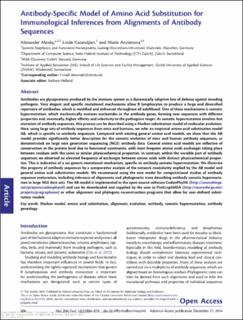Bitte benutzen Sie diese Kennung, um auf die Ressource zu verweisen:
https://doi.org/10.21256/zhaw-3886| Publikationstyp: | Beitrag in wissenschaftlicher Zeitschrift |
| Art der Begutachtung: | Peer review (Publikation) |
| Titel: | Antibody-specific model of amino acid substitution for immunological inferences from alignments of antibody sequences |
| Autor/-in: | Mirsky, Alexander Anisimova, Maria Kazandjian, Linda |
| DOI: | 10.21256/zhaw-3886 10.1093/molbev/msu340 |
| Erschienen in: | Molecular Biology and Evolution |
| Band(Heft): | 32 |
| Heft: | 3 |
| Seite(n): | 806 |
| Seiten bis: | 819 |
| Erscheinungsdatum: | 2014 |
| Verlag / Hrsg. Institution: | Oxford University Press |
| ISSN: | 0737-4038 1537-1719 |
| Sprache: | Englisch |
| Schlagwörter: | Markov model; Amino acid substitution; Alignment; Evolution; Antibody; Somatic hypermutation; Antibody genealogy |
| Fachgebiet (DDC): | 572: Biochemie |
| Zusammenfassung: | Antibodies are glycoproteins produced by the immune system as a dynamically adaptive line of defense against invading pathogens. Very elegant and specific mutational mechanisms allow B lymphocytes to produce a large and diversified repertoire of antibodies, which is modified and enhanced throughout all adulthood. One of these mechanisms is somatic hypermutation, which stochastically mutates nucleotides in the antibody genes, forming new sequences with different properties and, eventually, higher affinity and selectivity to the pathogenic target. Since somatic hypermutation involves fast mutation of antibody sequences, this process can be described using a Markov substitution model of molecular evolution. Here, using large sets of antibody sequences from mice and humans, we infer an empirical amino acid substitution model AB, which is specific to antibody sequences. Compared to existing general amino acid models, we show that the AB model provides significantly better description for the somatic evolution of mice and human antibody sequences, as demonstrated on large next generation sequencing (NGS) antibody data. General amino acid models are reflective of conservation at the protein level due to functional constraints, with most frequent amino acids exchanges taking place between residues with the same or similar physicochemical properties. In contrast, within the variable part of antibody sequences we observed an elevated frequency of exchanges between amino acids with distinct physicochemical properties. This is indicative of a sui generis mutational mechanism, specific to antibody somatic hypermutation. We illustrate this property of antibody sequences by a comparative analysis of the network modularity implied by the AB model and general amino acid substitution models. We recommend using the new model for computational studies of antibody sequence maturation, including inference of alignments and phylogenetic trees describing antibody somatic hypermutation in large NGS data sets. The AB model is implemented in the open-source software CodonPhyML (http://sourceforge.net/projects/codonphyml) and can be downloaded and supplied by the user to ProGraphMSA (http://sourceforge.net/projects/prographmsa) or other alignment and phylogeny reconstruction programs that allow for user-defined substitution models. |
| URI: | https://digitalcollection.zhaw.ch/handle/11475/8270 |
| Volltext Version: | Publizierte Version |
| Lizenz (gemäss Verlagsvertrag): | CC BY 4.0: Namensnennung 4.0 International |
| Departement: | Life Sciences und Facility Management |
| Organisationseinheit: | Institut für Computational Life Sciences (ICLS) |
| Enthalten in den Sammlungen: | Publikationen Life Sciences und Facility Management |
Dateien zu dieser Ressource:
| Datei | Beschreibung | Größe | Format | |
|---|---|---|---|---|
| msu340.pdf | 593.17 kB | Adobe PDF |  Öffnen/Anzeigen |
Zur Langanzeige
Mirsky, A., Anisimova, M., & Kazandjian, L. (2014). Antibody-specific model of amino acid substitution for immunological inferences from alignments of antibody sequences. Molecular Biology and Evolution, 32(3), 806–819. https://doi.org/10.21256/zhaw-3886
Mirsky, A., Anisimova, M. and Kazandjian, L. (2014) ‘Antibody-specific model of amino acid substitution for immunological inferences from alignments of antibody sequences’, Molecular Biology and Evolution, 32(3), pp. 806–819. Available at: https://doi.org/10.21256/zhaw-3886.
A. Mirsky, M. Anisimova, and L. Kazandjian, “Antibody-specific model of amino acid substitution for immunological inferences from alignments of antibody sequences,” Molecular Biology and Evolution, vol. 32, no. 3, pp. 806–819, 2014, doi: 10.21256/zhaw-3886.
MIRSKY, Alexander, Maria ANISIMOVA und Linda KAZANDJIAN, 2014. Antibody-specific model of amino acid substitution for immunological inferences from alignments of antibody sequences. Molecular Biology and Evolution. 2014. Bd. 32, Nr. 3, S. 806–819. DOI 10.21256/zhaw-3886
Mirsky, Alexander, Maria Anisimova, and Linda Kazandjian. 2014. “Antibody-Specific Model of Amino Acid Substitution for Immunological Inferences from Alignments of Antibody Sequences.” Molecular Biology and Evolution 32 (3): 806–19. https://doi.org/10.21256/zhaw-3886.
Mirsky, Alexander, et al. “Antibody-Specific Model of Amino Acid Substitution for Immunological Inferences from Alignments of Antibody Sequences.” Molecular Biology and Evolution, vol. 32, no. 3, 2014, pp. 806–19, https://doi.org/10.21256/zhaw-3886.
Alle Ressourcen in diesem Repository sind urheberrechtlich geschützt, soweit nicht anderweitig angezeigt.